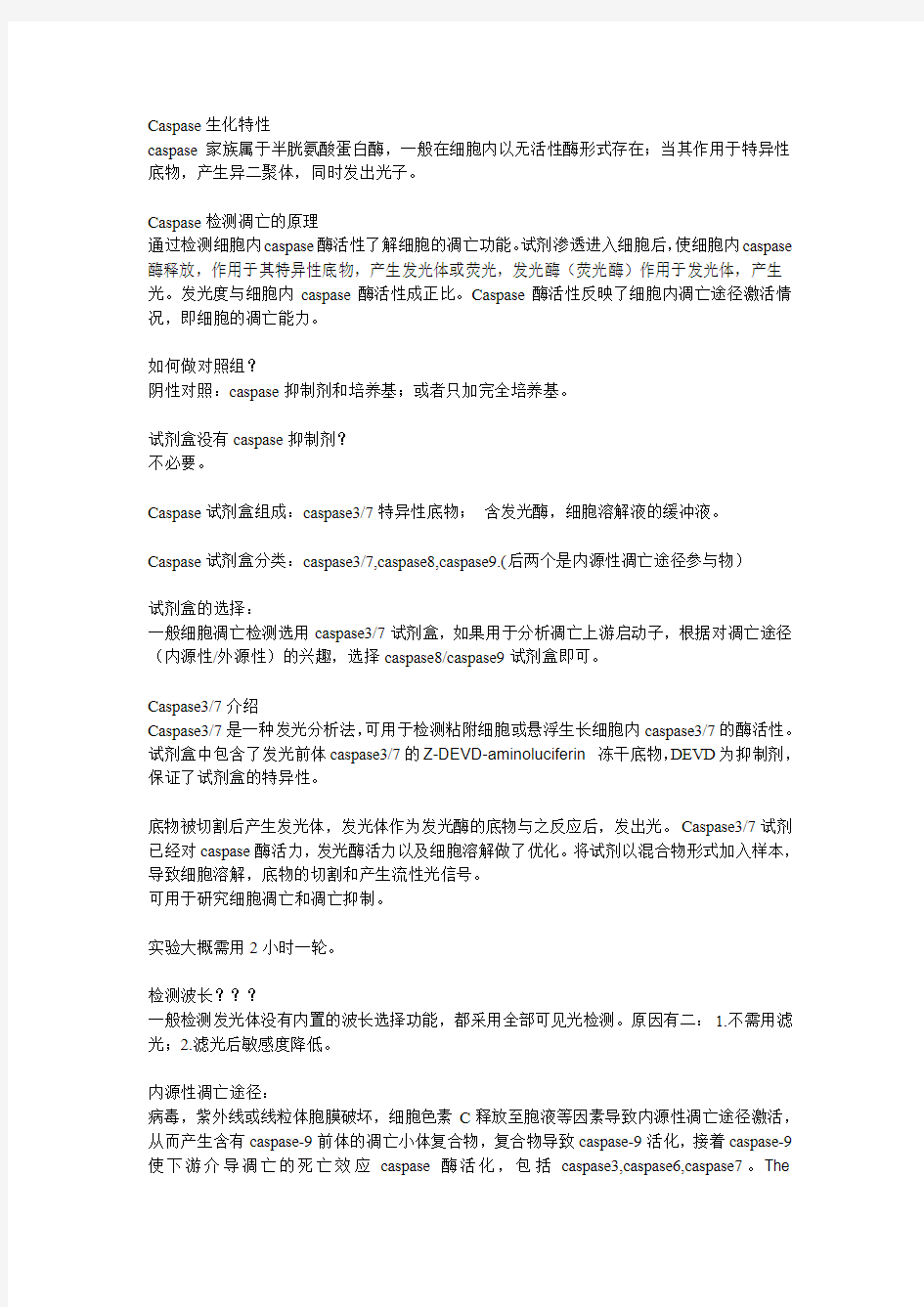

Caspase生化特性
caspase家族属于半胱氨酸蛋白酶,一般在细胞内以无活性酶形式存在;当其作用于特异性底物,产生异二聚体,同时发出光子。
Caspase检测凋亡的原理
通过检测细胞内caspase酶活性了解细胞的凋亡功能。试剂渗透进入细胞后,使细胞内caspase 酶释放,作用于其特异性底物,产生发光体或荧光,发光酶(荧光酶)作用于发光体,产生光。发光度与细胞内caspase酶活性成正比。Caspase酶活性反映了细胞内凋亡途径激活情况,即细胞的凋亡能力。
如何做对照组?
阴性对照:caspase抑制剂和培养基;或者只加完全培养基。
试剂盒没有caspase抑制剂?
不必要。
Caspase试剂盒组成:caspase3/7特异性底物;含发光酶,细胞溶解液的缓冲液。
Caspase试剂盒分类:caspase3/7,caspase8,caspase9.(后两个是内源性凋亡途径参与物)
试剂盒的选择:
一般细胞凋亡检测选用caspase3/7试剂盒,如果用于分析凋亡上游启动子,根据对凋亡途径(内源性/外源性)的兴趣,选择caspase8/caspase9试剂盒即可。
Caspase3/7介绍
Caspase3/7是一种发光分析法,可用于检测粘附细胞或悬浮生长细胞内caspase3/7的酶活性。试剂盒中包含了发光前体caspase3/7的Z-DEVD-aminoluciferin 冻干底物,DEVD为抑制剂,保证了试剂盒的特异性。
底物被切割后产生发光体,发光体作为发光酶的底物与之反应后,发出光。Caspase3/7试剂已经对caspase酶活力,发光酶活力以及细胞溶解做了优化。将试剂以混合物形式加入样本,导致细胞溶解,底物的切割和产生流性光信号。
可用于研究细胞凋亡和凋亡抑制。
实验大概需用2小时一轮。
检测波长???
一般检测发光体没有内置的波长选择功能,都采用全部可见光检测。原因有二:1.不需用滤光;2.滤光后敏感度降低。
内源性凋亡途径:
病毒,紫外线或线粒体胞膜破坏,细胞色素C释放至胞液等因素导致内源性凋亡途径激活,从而产生含有caspase-9前体的凋亡小体复合物,复合物导致caspase-9活化,接着caspase-9使下游介导凋亡的死亡效应caspase酶活化,包括caspase3,caspase6,caspase7。The
Caspase-Glo? 9 Assay 试剂盒就检测细胞内产生的内源性caspase9。
外源性凋亡途径:
受体介导或者死亡受体超家族的肿瘤坏死因子交叉反应,产生死亡诱导信号复合物(DISC),其中包含具有自我催化能力的caspase-8蛋白酶,caspase-8进一步作用后,活化下游死亡效应caspase酶,包括caspase3,caspase6,caspase7。导致结构片段降解或者修复酶。The Caspase-Glo? 8 Assay试剂盒用于检测活化的caspase-8。
摸索:
处理后分析的最佳时间点;
目前关键是:检测光的仪器。
caspase家族及在细胞凋亡中的作用 admin 注:本文仅是基础知识,目前这方面进展十分快,需要更新更多的知识。如caspase家族目前发现至少14种。这里仅介绍几种常见的成员。目的是让大家了解到caspase家族的概况,以及在细胞凋亡中的作用。 一caspase家族蛋白酶的组成 未活化的caspase家族蛋白酶是以酶原形式存在的,酶原的氨基端有一段被称为“原结构域”(pro-domain)的序列。酶原活化时不但要将原结构域切除,并且要将剩余部分剪切成一大一小两个亚基,分别称为P20和P10,活性酶就是由这两种亚基以(P20/P10) 2 的形式组成的。这种活化反应也是Asp特异的,剪切发生在酶原中保守序列的Asp与其后的氨基酸残基之间,一般是先切下羧基端的小亚基,然后再从大亚基的氨基端切去原结构域。这种剪切可以是酶原及中间活性酶自我催化,也可以是其它ICE家族蛋白酶的作用,还有其它酶类如颗粒酶B 参与。 表5. caspase家族蛋白酶的识别序列及作用底物 蛋白酶名称别名识别序 列 底物 caspase 1ICE YVAD pro-IL-1 , pro-caspase 3, pro-caspase 4 caspase 4TX, ICH-2, ICErel-II pro-caspase 1 caspase 5ICErel-III, TY mICH3 mICH4 caspase 2ICH-1PARP caspase 9ICE-LAP6, Mch6PARP
caspase 3CPP32, Yama, apopain DEVD PARP, DNA-PK, SRE/BP, rho-GDI, KCθ caspase 6Mch2VEID lamin A caspase 7Mch3, ICE-LAP3, CMH-1 DEVD PARP, pro-caspase 6 caspase 8MACH, FLICE, Mch5DEVD pro-caspase3,4,7,9,10 caspase 10Mch4YVAD caspase 11ICH3, FLICE2 CED-3 已命名的caspase家族成员均已克隆成功,它们不但在氨基酸序列上具有同源性,而且在空间结构上也很相似。目前已经获得了caspase-1(ICE)和caspase-3(CPP32)的X线结晶图像,结果显示它们具有相似的空间结构,在P20的C端和P10的N端有200多个氨基酸残基的序列尤为保守,在空间结构上组成相似的β折叠中心和相邻的α螺旋,保守的、对蛋白酶活性有特殊意义的氨基酸残基均位于这一段,并形成特定的结构。不同源的序列主要存在于P20的N 端和P20与P10交界处,这两个部位的氨基酸残基在蛋白酶活化过程中一般被全部或部分切除。 所有的成员都保守性地包含有与底物P 1 Asp作用的氨基酸残基,如在ICE中,它们是催化中心的Cys285,与酶/抑制剂复合物的巯基半缩醛以氢键结合的His237,以及可以稳定反应中间物氧 阴离子的Gly238。另外,Arg179、Arg341、Gln383和Ser347形成容纳P 1 Asp的“口袋”,Ser339靠近 Cys285的巯基,以氢键结合P 1位的酰胺。与P 2 ~P 4 作用的氨基酸残基则变异比较大,这可能是各 个成员识别不同底物的特异性之所在。在活性Cys周围的氨基酸序列也很保守,一般都有Gln-Ala-Cys-Arg-Gly(QACRG)五肽序列,在caspase-8、caspase-10中为QACQG,在caspase-9中是QACGG,这三个成员都有一个氨基酸残基的变异,但这种变异不影响蛋白酶的剪切活性和特异性。
(一)caspase家族 Caspases是近年来发现的一组存在于胞质溶胶中的结构上相关的半胱氨酸蛋白酶,它们的一个重要共同点是特异地断开天冬氨酸残基后的肽键。Caspase一词是从Cysteine aspartic acid specific protease 的字头缩写衍生而来,就反映了这个特征,而这种高度的特异性,在蛋白酶中是很少见的。由于这种特异性,使caspase能够高度选择性地切割某些蛋白质,这种切割只发生在少数(通常只有1个)位点上,主要是在结构域间的位点上,切割的结果或是活化某种蛋白,或使某种蛋白失活,但从不完全降解一种蛋白质。 Caspase的研究源于线虫(C. elegans)细胞程序化死亡的研究。线虫在发育过程中,有131个细胞将进入程序化死亡;研究发现有11个基因与PCD 有关,其中ced3和ced4基因是决定细胞凋亡所必需的,ced9基因抑制PCD。线虫细胞程序化死亡的研究促进了其他动物特别是哺乳类动物中细胞凋亡的研究。人们发现哺乳类细胞中存在着Ced3的同源物ICE(interleukin-1b converting enzyme),它催化白介素-1b的活化,即从其前体上将IL-1b 切割下来。在大鼠成纤维细胞中过量表达ICE和Ced3都会引起细胞凋亡,表明了ICE和Ced3在结构和功能上的相似性;然而敲除ICE基因的小鼠其表现型正常,并未发现细胞凋亡发生明显改变。进一步的研究发现,另一个ICE成员,后来被称为apopain,CPP32或Yama的半胱氨酸蛋白酶,催化poly(ADP-ribose)Polymerase(PARP),即聚(ADP-核糖)聚合酶的裂解,结果导致细胞的凋亡,因而认为apopain执行着与线虫中的ced3相同的功能。Apopain被称为是“死亡酶”,而PARP被认为是“死亡底物”。 Apopain/CPP32/Yama是在1995年由两个实验室分别同时报导,时间上只有两周之差。Ced4的哺乳类同源物则迟迟未能发现,直到1997年,才被证明是Apaf-1(即一种细胞凋亡蛋白酶活化因子apoptosis protease activating factor)。而Ced 9的哺乳类对应物则较早地被证明是BCL-2,这一问题将在以后的部分述及。 现已确定至少存在11种caspase: 这些caspases中,caspase 1和caspase 11,以及可能还有caspase 4被认为不直接参与凋亡信号的转导,它们主要参与白介素前体的活化;而caspase 2,caspase 8,caspase 9和caspase 10参与细胞凋亡的起始;参与细胞凋亡执行的则是caspase 3,caspase 6和caspase 7,其中caspase 3和7具有相近的底物和抑制剂特异性,它们降解PARP,DFF-45(DNA fragmentation factor-45),导致DNA修复的抑制并启动DNA的降解。而
·397· 中华普通外科学文献(电子版)2013年10月第7卷第5期Chin Arch Gen Surg(Electronic Edition),October 2013,Vol.7,No.5 ·综述· 线粒体自噬在肝相关疾病中的作用 王超臣 张培建 DOI:10.3877/cma.j.issn.1674-0793.2013.05.016 基金项目:扬州市科技攻关项目(YZ2009051,YZ2010087)作者单位:225002 扬州大学第二临床医学院普通外科研究室 线粒体是细胞内氧化磷酸化的场所,为细胞生命活动提供能量,在细胞生存和死亡中扮演着重要角色。通过氧化磷酸化产生ATP 是线粒体最为重要的功能之一,线粒体通过氧化磷酸化高效产生ATP 的同时,还伴随产生O 2、H 2O 2等,线粒体外膜如果因受ROS 攻击而破裂,会使线粒体向胞质内释放细胞色素C 凋亡诱导因子(apoptosis-inducing factor, AIF)等凋亡相关蛋白,从而诱导细胞进入凋亡途径。细胞主要通过自噬机制选择性地清除受损伤或不需要的线粒体,这一过程被称为线粒体自噬(mitochondrial autophagy,mitophagy)[1]。但是,线粒体自噬可以作为一种防御机制能清除损伤的线粒体和过量产生的ROS,确保细胞内线粒体功能稳定,促进应激环境中细胞的存活;反之,如果线粒体自噬的防御功能得不到充分发挥,过量产生的ROS 将诱导细胞进入凋亡等途径,导致细胞死亡[2]。早在1962年就有 文献报道通过电镜观察发现了很多被膜结构包裹的线粒体,并且这些线粒体随后会被溶酶体降解掉。但线粒体自噬这一概念由Lemasters 于2005年正式提出[3],他观察到线粒体膜电位降低和线粒体通透性膜孔开放能引起线粒体自噬,并认为线粒体自噬可能在减少由衰老引起的线粒体DNA 突变中起着重要的作用。越来越多的研究表明线粒体的清除是一个选择性的过程,线粒体自噬的研究是目前细胞生物学和线粒体研究领域的热点。近来有大量文献显示线粒体自噬参与多个肝脏相关疾病,本文就线粒体自噬及其在肝脏疾病中的作用综述如下。 一、线粒体能量代谢与肝脏功能 线粒体是真核细胞中一种非常重要的细胞器,与肝脏的生物合成、代谢和解毒功能密不可分。三羧酸循环、脂肪酸β-氧化、氧化磷酸化及鸟氨酸循环等均在线粒体内进行[4]。此外,线粒体在调节细胞内钙离子浓度、信息传递及细胞死亡等过程中也具有重要作用。线粒体是肝细胞内较敏感的细胞器之一,多种急、慢性肝病均存在线粒体结构和功能的异常[5-6]。当线粒体受损时,ATP 【摘要】 细胞自噬是细胞依赖溶酶体的分解代谢过程,能降解受损蛋白、衰老或损伤的细胞器等细胞结构,来维持细胞内稳态。众所周知,线粒体调节异常是许多疾病的发病机制。本文主要探讨线粒体自噬在肝相关疾病如非酒精性脂肪肝病、肝癌和肝缺血再灌注损伤中的作用。 【关键词】 线粒体自噬;非酒精性脂肪肝病;肝癌;缺血再灌注损伤 Targeting mitophagy for the treatment of liver diseases WANG Chao-chen, ZHANG Pei-jian. General Surgery, Yangzhou No.1 People's Hospital, the Second Clinical Medical College, Yangzhou 225002, China 【Abstract】 Autophagy is a lysosomal degradation pathway that can degrade bulk cytoplasm and superfluous or damaged organelles, such as mitochondria, to maintain cellular homeostasis. It is known that dysregulation of mitochondrial autophagy can cause pathogenesis of numerous human diseases. Here, we discuss the critical roles that mitochondrial autophagy plays in the pathogenesis of liver diseases such as non-alcoholic and alcoholic fatty liver, liver cancer, and hepatic ischemia reperfusion injury. 【Key words】 Mitochondrial autophagy; Nonalcoholic fatty liver disease; Liver cancer; Ischemia-reperfusion injury
caspase家族蛋白酶的组成 已命名的caspase家族成员均已克隆成功,它们不但在氨基酸序列上具有同源性,而且在空间结构上也很相似。目前已经获得了caspase-1(ICE)和caspase-3(CPP32)的X线结晶图像,结果显示它们具有相似的空间结构,在P20的C端和P10的N端有200多个氨基酸残基的序列尤为保守,在空间结构上组成相似的β折叠中心和相邻的α螺旋,保守的、对蛋白酶活性有特殊意义的氨基酸残基均位于这一段,并形成特定的结构。不同源的序列主要存在于P20的N端和P20与P10交界处,这两个部位的氨基酸残基在蛋白酶活化过程中一般被全部或部分切除。 所有的成员都保守性地包含有与底物P1Asp作用的氨基酸残基,如在ICE中,它们是催化中心的Cys285,与酶/抑制剂复合物的巯基半缩醛以氢键结合的His237,以及可以稳定反应中间物氧阴离子的Gly238。另外,Arg179、Arg341、Gln383和Ser347形成容纳P1Asp的“口袋”,Ser339靠近Cys285的巯基,以氢键结合P1位的酰
胺。与P2~P4作用的氨基酸残基则变异比较大,这可能是各个成员识别不同底物的特异性之所在。在活性Cys周围的氨基酸序列也很保守,一般都有Gln-Ala-Cys-Arg-Gly(QACRG)五肽序列,在caspase-8、caspase-10中为QACQG,在caspase-9中是QACGG,这三个成员都有一个氨基酸残基的变异,但这种变异不影响蛋白酶的剪切活性和特异性。 未活化的caspase家族蛋白酶是以酶原形式存在的,酶原的氨基端有一段被称为“原结构域”(pro-domain)的序列。酶原活化时不但要将原结构域切除,并且要将剩余部分剪切成一大一小两个亚基,分别称为P20和P10,活性酶就是由这两种亚基以(P20/P10)2的形式组成的。这种活化反应也是Asp特异的,剪切发生在酶原中保守序列的Asp与其后的氨基酸残基之间,一般是先切下羧基端的小亚基,然后再从大亚基的氨基端切去原结构域。这种剪切可以是酶原及中间活性酶自我催化,也可以是其它ICE家族蛋白酶的作用,还有其它酶类如颗粒酶B参与。二caspase家族蛋白酶的结构与功能 按照结构同源性的大小,可以将caspase蛋白酶分为三个组,分别以caspase-1、caspase-2和caspase-3为代表。其中最重要的是caspase-1、caspase-3 和caspase-8。
Caspase家族 Caspases是近年来发现的一组存在于胞质溶胶中的结构上相关的半胱氨酸蛋白酶,它们的一个重要共同点是特异地断开天冬氨酸残基后的肽键。Caspase一词是从Cysteine aspartic acid specific protease 的字头缩写衍生而来,就反映了这个特征,而这种高度的特异性,在蛋白酶中是很少见的。 由于这种特异性,使caspase能够高度选择性地切割某些蛋白质,这种切割只发生在少数(通常只有1个)位点上,主要是在结构域间的位点上,切割的结果或是活化某种蛋白,或使某种蛋白失活,但从不完全降解一种蛋白质。 Caspase的研究源于线虫(C. elegans)细胞程序化死亡的研究。线虫在发育过程中,有131个细胞将进入程序化死亡;研究发现有11个基因与PCD有关,其中ced3和ced4基因是决定细胞凋亡所必需的,ced9基因抑制PCD。线虫细胞程序化死亡的研究促进了其他动物特别是哺乳类动物中细胞凋亡的研究。人们发现哺乳类细胞中存在着Ced3的同源物ICE (interleukin-1b converting enzyme),它催化白介素-1b的活化,即从其前体上将IL-1b切割下来。在大鼠成纤维细胞中过量表达ICE和Ced3都会引起细胞凋亡,表明了ICE和Ced3在结构和功能上的相似性;然而敲除ICE基因的小鼠其表现型正常,并未发现细胞凋亡发生明显改变。进一步的研究发现,另一个ICE成员,后来被称为apopain,CPP32或Yama的半胱氨酸蛋白酶,催化poly(ADP-ribose)Polymerase(PARP),即聚(ADP-核糖)聚合酶的裂解,结果导致细胞的凋亡,因而认为apopain执行着与线虫中的ced3相同的功能。Apopain被称为是“死亡酶”,而PARP被认为是“死亡底物”。 Apopain/CPP32/Yama是在1995年由两个实验室分别同时报导,时间上只有两周之差。Ced4的哺乳类同源物则迟迟未能发现,直到1997年,才被证明是Apaf-1(即一种细胞凋亡蛋白酶活化因子apoptosis protease activating factor)。而Ced 9的哺乳类对应物则较早地被证明是BCL-2,这一问题将在以后的部分述及。 现已确定至少存在11种caspase: 这些caspases中,caspase 1和caspase 11,以及可能还有caspase 4被认为不直接参与凋亡信号的转导,它们主要参与白介素前体的活化;而caspase 2,caspase 8,caspase 9和caspase 10参与细胞凋亡的起始;参与细胞凋亡执行的则是caspase 3,caspase 6和caspase 7,其中caspase
Caspases are a family of cysteine proteases that act in concert in a cascade triggered by apoptosis signaling. The culmination of this cascade is the cleavage of a number of proteins in the cell, followed by cell disassembly, cell death, and, ultimately, the phagocytosis and removal of the cell debris. The Caspase cascade is activated by two distinct routes: one from cell surface and the other from mitochondria (Ref.1). The pathway leading to Caspase activation varies according to the apoptotic stimulus. Initiator Caspases (including 8, 9, 10 and 12) are closely coupled to pro-apototic signals. Pro-apoptotic stimuli include the FasL (Fas Ligand), TNF (Tumor Necrosis Factor), Granzyme-B, GRB (Growth Factor Receptor-Bound Protein), DNA damage, Ca2+ (Calcium) channels and ER (Endoplasmic Reticulum) stress. Once activated, these Caspases cleave and activate downstream effector Caspases (including 3, 6 and 7). Caspase8 cleaves BID (BH3 Interacting Death Domain). tBID (Truncated BID) disrupts the outer mitochondrial membrane to cause release of the pro-apoptotic factors CytoC (Cytochrome-C) which is crucial for activating pro-Caspase9. CytoC that is released from the intermembrane space binds to APAF1 (Apoptotic Protease Activating Factor-1), which recruits Caspase9 and in turn can proteolytically activate Caspase3. SMAC (Second Mitochondria-Derived Activator of Caspase)/DIABLO is also released from the mitochondria along with CytoC during apoptosis, and it functions to promote caspase activation by inhibiting IAP (Inhibitor of Apoptosis) family proteins. ER stress leads to the Ca2+-mediated activation of Caspase12 (Ref.2). Fas and the TNFR (TNF Receptor) activate Caspases8 and 10. Cell death caused by activation of the TNFR or Fas receptors is brought about by the recruitment of the adaptor protein FADD (Fas Associated Death Domain). In the case of the TNFR1, FADD recruitment requires prior binding of TRADD (TNFR-Associated Death Domain Protein). FADD in turn recruits ProCaspase8. The TNFR1 receptor can also mediate activation of Caspase2 via the recruitment of a death-inducing signaling complex. In this case RIP (Receptor-Interacting Protein) acts as an adaptor for the recruitment of RAIDD (RIP-Associated ICH-1/CED-3-homologous protein with a Death Domain), which subsequently binds to ProCaspase2. TNFR also activates Caspase3, 6,7 via TRADD, TRAF2 (TNF Receptor-Associated Factor-2) and RICK (RIP-like Interacting Clarp Kinase). TNF not only induces apoptosis by activating Caspase8 and 10, but can also inhibit apoptosis signaling via NF-KappaB (Nuclear Factor-KappaB), which induces the expression of IAP, an inhibitor of Caspases3, 7 and 9 (Ref.3). GRB (Growth Factor Receptor-Bound Protein), Granzyme B and perforin proteins released by cytotoxic T-Cells induce apoptosis in target cells, forming transmembrane pores, and triggering apoptosis, perhaps through cleavage of Caspases, although Caspase-independent mechanisms of Granzyme-B mediated apoptosis have been suggested (Ref.4). After activation, down stream Caspases cleave cytoskeletal and nuclear proteins (structural, signaling proteins or kinases) like PARP (Poly ADP-Ribose Polymerase), DNA-PK (DNA-Dependent Protein Kinase), Rb (Retino Blastoma Tumor Supressor Protein), PAK1 (p21-Activated Kinase-1), GDID4, Fodrin, Lamin-A, Lamin-B1, Lamin-B2, thus inducing apoptosis. Caspase3 cleaves ICAD (Inhibitor of CAD) to free CAD (Caspase-Activated DNase) to cause DNA fragmentation. The events culminating in Caspase activation and the subsequent disassembly of the cell are the subject of intense study because of their role in many neurodegenerative disorders such as Parkinson's and Alzheimer’s diseases, autoimmune disorders, and tumorigenesis. References: 1. Srinivasula SM,Ahmad M,Fernandes-Alnemri T,Alnemri ES. Autoactivation of procaspase-9 by Apaf-1-mediated oligomerization. Mol Cell. 1998 Jun;1(7):949-57. 2. Pirnia F,Schneider E,Betticher DC,Borner MM. Mitomycin C induces apoptosis and caspase-8 and -9 processing through a caspase-3 and Fas-independent pathway. Cell Death Differ. 2002 Sep;9(9):905-14.
中国法医学杂志CH I N J FO R EN S I C M ED 2006年第21卷第2期 【基金项目】国家自然科学基金资助项目(30271347);教育部留学归国基金资助项目(教外留司[2000]367号) 【作者简介】韩阳(1980-),男,山东省德州人,硕士研究生,主要从事皮肤损伤愈合机制的研究。 【通讯作者】官大威(1963-),男,教授,博士生导师,主要从事皮肤损伤愈合机制及钝力性心脏外伤研究。综 述 cas pase-8及其研究进展 韩 阳,官大威,侯震寰,赵 锐,路 斌 (中国医科大学法医学院法医病理学教研室,辽宁沈阳110001) 【摘要】细胞凋亡是细胞生理性自主死亡的过程,一组被称为cas pase的蛋白酶蛋白水解系统是该过程的核心。Fas(AP O-1/C D95)是一种跨细胞膜受体,其活化后会引发细胞凋亡。在Fas引发的凋亡过程中一系列cas pase级联式地活化,其中cas pase-8的活化是其第一步反应。活化后的cas pase-8会引发包括cas pase-9在内的下游cas pase活化,进而诱导细胞凋亡。cas pase-8与人类的诸多疾病及损伤的病理变化有关,如癌症、神经退化性疾病、寄生虫病及创伤等。随着对cas pase-8的结构、功能和调控等方面研究的不断深入,将会发现更多有关cas pase-8的生物学作用。 【关键词】法医病理学;cas pase-8;凋亡;死亡受体;损伤 【文献标识码】A 【文章编号】100125728(2006)02-0094-03 Ca spa se-8and its advances i n rel a ted stud i es/(△HAN Yang,G UAN Da2wei,HOU Zhen2huan,et al./△D epart m ent of Forensic Pathology,China M edical U niversity School of Forensic M edicine,Shenyang 110001,China) 【Abstract】Apop t osis is a physi ol ogical p r ocess of cellular aut odestructi on.The central component of this machinery is a p r oteolytic syste m involving a fa m ily of p r oteases called cas pases.Fas(AP O-1/CD95) is a trans me recep t or p r otein which induces apop t osis upon activati on.I n apop t osis triggered by Fas, a subset of cas pases is activated.Among the m,cas pases-8(F L I CE/MACH)is the first step in the cas2 cade of apop t otic events induced by Fas.Cleavaged cas pase-8then activates other downstrea m cas pases including cas pase-9,thereby comm iting the cell t o undergo apop t osis.Many studies show that cas pase-8 is related t o the pathogenesis of certain diseases and injuries such as cancers,neur odegenerative diseases, parasit osis,trau ma and s o on in hu man beings. W ith the continuous researches in the structure,functi on and regulati on of cas pase-8,more as pects on cas pase-8and its bi ol ogical functi ons will be underst ood. 【Key words】Forensic pathol ogy;Cas pase-8;Apop t osis;Death recep t or;I njury 细胞凋亡(apop t osis)是基因控制的细胞自主性死亡。cas pase(cystine containing as parate s pecific p r otease)意为含半胱氨酸的天冬氨酸特异水解酶,是凋亡的主要执行者。已发现的14种cas pase均以酶原(p r ocas pase)形式合成并定位于细胞内不同的亚细胞部位。cas pase分为3大类型:启动型、效应型和炎症型。启动型cas pase包括cas pase-2、-8、-9、-10,通过自身活化启动凋亡并调节效应型cas pase;效应型cas pase 包括cas pase-3、-6、-7,能分解细胞蛋白,执行凋亡;炎症型cas pase包括cas pase-1、-4、-5等。cas pase的结构可分为前结构域(p r odomain)、大亚基和小亚基[后二者统称为催化域(catalytic domain)][1]三部分。在p r ocas pase被切割为大、小两个片段(约20k Da和10k Da,分别为p20和p10)及一个N-端前区后,两大两小共4个片段聚合成为含有两个位点活化了的cas pase。 1 cas pase-8参与细胞凋亡的机制 cas pase-8也称MACH、F L I CE、Mch5,1996年被克隆成功。cas pase-8基因C ASP8与c-F L I P(cellular F L I CE inhibi2 t ory p r otein)基因及cas pase-10基因C ASP10共同位于染色体2q33-34。cas pase-8以无活性的酶原(p r ocas pase-8)形式存在于成人及除胎儿脑组织外的各种组织中,在外周血白细胞中分布较高。p r ocas pase-8有479个氨基酸,分子量为55k D,其8种异构体(is of or m s)中2种有完整的酶活性,能启动死亡受体介导的凋亡。这2种p r ocas pase-8的N-端的两个前后串联的70个氨基酸左右死亡效应结构域(death effect domain,DE D)与适配蛋白(adap ter p r otein,如fas-ass ociated death domain,F ADD)N-端的DE D同源,所以p r ocas pase-8可与F ADD结合。C-端的大小两个亚基是蛋白水解酶区域, ? 4 9 ?
SANTA CRUZ BIOTECHNOLOGY, INC. caspase-1(14F468):sc-56036 Santa Cruz Biotechnology,Inc. 1.800.457.3801831.457.3800fax 831.457.3801Europe +https://www.doczj.com/doc/487264802.html, BACKGROUND Caspase-1,originally designated ICE (for IL-1converting enzyme),is a member of the group of caspases with large prodomains.Caspase-1promotes matura-tion of interleukin IL-1βand interleukin18(IL-18)by proteolytic cleavage of precursor forms into biologically active pro-inflamatory cytokines.Active caspase-1,a (p20/p10)2tetramer,is necessary and sufficient for cleavage of precursor IL-1as well as for induction of apoptosis in some cell lines.The highly conserved family of caspases mediate many of the morphological and biochemical features of apoptosis,including structural dismantling of cell bodies and nuclei,fragmentation of genomic DNA,destruction of regulatory proteins and propagation of other pro-apoptotic molecules.The human cas-pase-1gene maps to chromosome 2q14and encodes a cytoplasmic protein expressed in liver,heart,skeletal muscle kidney and testis.caspase-1is implicated in inflammation,septic shock,and other situations such as wound healing and the growth of certain leukemias. REFERENCES 1.Alnemri,E.S.,et al.1995.Cloning and expression of four novel isoforms of human interleukin-1βconverting enzyme with different apoptotic activities.J.Biol.Chem.270:4312-4317. 2.Gu,Y.,et al.1995.Interleukin-1βconverting enzyme requires oligomer-ization for activity of processed forms in vivo .Embo J.14:1923-1931. 3.Tatsuta,T.,et al.2000.The prodomain of caspase-1enhances Fas-mediated apoptosis through facilitation of caspase-8activation.J.Biol.Chem.275:14248-1425 4. 4.Wang,J.,et al.2000.Role of caspases in apoptosis,development,and cytokine maturation revealed by homozygous gene deficiencies.J.Cell.Sci.113:753-757. 5.Eldadah,B.A.and Faden,A.I.2000.Caspase pathways,neuonal apopto-sis,and CNS injury.J.Neurotrauma 10:811-829. 6.SWISS-PROT/TrEMBL (P29466).World Wide Web URL:http://www.expasy.ch/sprot/sprot-top.html CHROMOSOMAL LOCATION Genetic locus:CASP1(human)mapping to 11q23;Casp1(mouse)mapping to 9A1. SOURCE caspase-1(14F468)is a mouse monoclonal antibody raised against amino acids 371-390of caspase-1of human origin . PRODUCT Each vial contains 100μg IgG 1in 1.0ml of PBS with <0.1%sodium azide and 0.1%gelatin. STORAGE Store at 4°C,**DO NOT FREEZE**.Stable for one year from the date of shipment.Non-hazardous.No MSDS required. APPLICATIONS caspase-1(14F468)is recommended for detection of caspase-1of mouse,rat and human origin by Western Blotting (starting dilution 1:200,dilution range 1:100-1:1000),immunoprecipitation [1-2μg per 100-500μg of total protein (1ml of cell lysate)],immunofluorescence (starting dilution 1:50,dilution range 1:50-1:500)and immunohistochemistry (including paraffin-embedded sec-tions)(starting dilution 1:50,dilution range 1:50-1:500). Suitable for use as control antibody for caspase-1siRNA (h):sc-29235,caspase-1siRNA (m):sc-29922,caspase-1siRNA (r):sc-61878,caspase-1shRNA Plasmid (h):sc-29235-SH,caspase-1shRNA Plasmid (m):sc-29922-SH,caspase-1shRNA Plasmid (r):sc-61878-SH,caspase-1shRNA (h)Lentiviral Particles:sc-29235-V,caspase-1shRNA (m)Lentiviral Particles:sc-29922-V and caspase-1shRNA (r)Lentiviral Particles:sc-61878-V.Molecular Weight of caspase-1:45kDa. Positive Controls:HL-60whole cell lysate:sc-2209,HL-60+LPS cell lysate:sc-24704or Jurkat whole cell lysate:sc-2204. RECOMMENDED SECONDARY REAGENTS To ensure optimal results,the following support (secondary)reagents are recommended:1)Western Blotting:use goat anti-mouse IgG-HRP:sc-2005(dilution range:1:2000-1:32,000)or Cruz Marker?compatible goat anti-mouse IgG-HRP:sc-2031(dilution range:1:2000-1:5000),Cruz Marker?Molecular Weight Standards:sc-2035,TBS Blotto A Blocking Reagent:sc-2333and Western Blotting Luminol Reagent:sc-2048.2)Immunopre-cipitation:use Protein A/G PLUS-Agarose:sc-2003(0.5ml agarose/2.0ml).3)Immunofluorescence:use goat anti-mouse IgG-FITC:sc-2010(dilution range:1:100-1:400)or goat anti-mouse IgG-TR:sc-2781(dilution range:1:100-1:400)with UltraCruz?Mounting Medium:sc-24941.4)Immuno-histochemistry:use ImmunoCruz?:sc-2050or ABC:sc-2017mouse IgG Staining Systems. DATA RESEARCH USE For research use only,not for use in diagnostic procedures. caspase-1(14F468):sc-56036.Western blot analysis of caspase-1expression in HL-60(A ),LPS-treated HL-60(B )and THP-1(C )whole cell lysates. ----A B C Western blot analysis of caspase-1cleavage in untreated (A )and PMA (sc-3576)and LPS (sc-3535)treated (B )THP-1whole cell lysates.Antibody tested is caspase-1(14F468):sc-56036(A ,B ).Note cleavage of caspase-1in lane B . ––– – A B <